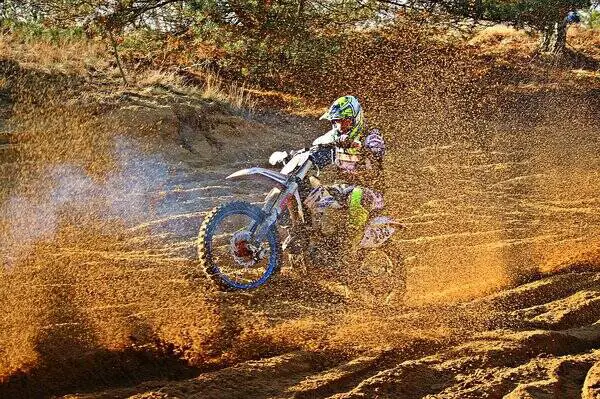How to keep your dirt bike from overheating? The question may have popped up when your dirt bike started feeling hot to the touch. Well, there is no short answer to that question.
Despite seeming tough and rugged, dirt bikes require a lot of TLC, much like any other vehicle. And often, negligence and wear can get the better of them. Overheating can be caused by leaks in the radiator, an inefficient coolant, a blown gasket, and even rich jetting.
Luckily, you can fix overheating issues quite easily. In some cases, it may be as simple as sealing a crack or replacing an O-ring. In others, however, you may need to service the engine and the cooling system.
With that being said, how do you keep your bike from overheating? And how do you identify leaks and gasket problems? We answer all this and more in our ultimate dirt bike overheating guide.
Do Dirt Bikes Overheat?

Yes, dirt bikes do overheat.
Heating in the engine is natural. Your engine has a lot of components that have to do a lot of work. And that’s not to mention that literal mini-explosions are happening in your engine’s cylinders. Heat is a natural byproduct of your vehicle’s processes. And most vehicles, including dirt bikes, have a cooling system to manage it.
But it’ll happen once or twice that your bike starts overheating. Is it all that big of a concern? Definitively. Overheating can warp components, cause leaks, and damage the engine permanently. Plus, excessive heat can lead to bad fuel mileage and lower fuel economy.
Common Reasons Why Your Dirt Bike Is Overheating:
Before you learn how to keep your dirt bike from overheating, here are some common causes for overheating;
Low Coolant:
The most common cause of overheating in your dirt bike is usually low coolant. There can be two underlying reasons for low coolant; you don’t refill enough, or your engine does not retain coolant.
Pop the cap off your radiator and check if there is enough coolant. It should be brimming with coolant before every ride.
However, if you constantly have to refill the coolant after every ride or so, you might leak.
Bad Radiator Cap:
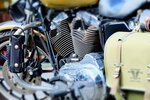
If you notice a leak in your coolant system, the radiator cap is the most likely culprit. You could be losing your coolant through your radiator’s cap. Pop it off and run it under soapy water to see if there are any leaks.
Blown Head Gasket:
For those of you who don’t notice any leaks in your radiator cap, consider whether you’ve blown your head gasket. This is the gasket that goes between your cylinder heads and the engine block. It prevents coolant and combustion gasses from escaping.
For this, you may have to dig deeper, remove the gasket, and examine it. Any obvious tears should be noticeable.
Bad Water Pump:
Another not-so-common cause for dirt bike overheating is a damaged water pump. If there is a leak in the pump, it will simply drizzle down to the ground. This type of problem is the least damaging as the coolant does not pool up and cause corrosion. However, it leads to inefficient cooling, which can damage your engine in the long run. You can replace the water pump or have a mechanic look at it.
Jetting Is Too Lean:
If you’ve jetted your bike, your jetting may be too lean. It refers to adjusting the fuel-air ratio of the carburetor to optimize the engine’s performance. Improper jetting will lead to a bike that sputters and overheats.
Riding Too Slow:

Finally, riding too slow may cause your dirt bike to overheat. It’s not rocket science. Your radiator needs a steady stream of moving air to radiate and dissipate heat.
When you’re moving too slowly, the air isn’t passing quickly enough, resulting in an inefficient radiator. You may think you’re conserving fuel, but you’re damaging your engine in the long run.
How to Inspect the Cooling System?
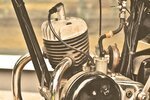
So, you’ve started to notice your dirt bike is overheating. How do you inspect the cooling system to identify the cause and potential leaks?
Start with the radiator cap. It’s the easiest to access and troubleshoot and the most common cause. Turn off your engine and wait for the system to cool down and the hoses to release their pressure. Then take the radiator cap off and check for obvious signs of a leak.
Due to the excessive pressure under the cap, sometimes the gasket can blow, or the O-ring can break. While you’re at it, take a look at the coolant level. It should be high. Check the coolant for any browning which may indicate impurities.
Another indicator your cooling system is faulty is, water or coolant is running onto the ground. Also, check if the oil looks milky, which signifies that your cooling system needs service.
Lastly, you can manually watch the coolant circulating in your bike. Leave the cap off and fill the coolant such that it covers the cores of the radiator. Turn on the bike and rev your engine up.
How To Keep Your Dirt Bike From Overheating: Common Dirt Bike Cooling System Problems
Bad Coolant:
One of the most common problems bikers face when dealing with an overheating bike is a bad coolant. Just like how your vehicle needs an oil change, be sure to keep changing the coolant every once in a while. Look up how often the manufacturer recommends servicing the coolant and follow that.
But sometimes, even with fresh coolant, your bike can start overheating. If you’re using a brand that’s not very well-known or highly reputed, then you may have a low-quality coolant. Consider swapping it for a better brand.
Idling Engine:
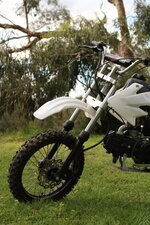
If you ask any expert how to keep your dirt bike from overheating, they’ll always tell you to stop idling. When your engine is idling, it is running just like it would if it weren’t idling. However, the power output of the engine isn’t being transferred to the drive chain. This not only means more power loss but also that your radiator isn’t getting enough ventilation.
Turn off the engine of your dirt bike when you know that you won’t be driving for a while. Don’t keep your engine idling when talking to someone, attending a call, or stopping at a red light.
Radiator Leakage:
Perhaps one of the most common causes of an overheating system, radiator leakage, is a major red flag. Your radiator is responsible for dissipating heat and keeping your system cool. If there’s a leak in it, you could be losing expensive amounts of coolant.
Faulty Engine:
Not every overheating bike is a result of bad habits or a leaking radiator. Sometimes, the problem is innate. Engines that have been dragged past their lifespan will ultimately fail and overheat. Several problems could be the cause of this.
Your engine will lose its structural integrity and gradually start to deform, resulting in more leaks and broken seals. Gaskets, seals, and valves can also malfunction.
Clogged Radiator:
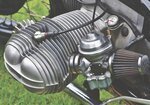
Aside from a leaking radiator, a clogged radiator also leads to overheating. Sometimes objects will get lodged in the radiator during crashes and roosts. And other times, there could be a significant dent or bend in the radiator. When this happens, the path of the coolant will get blocked or hindered, resulting in an overhang bike.
How Do You Tell If A Dirt Bike Has A Blown Head Gasket?
In case you’re worried that you’ve blown a head gasket, there are a few signs that you can look for:
Coolant Leaking From The Overflow Tube:
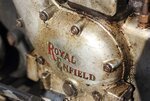
If you’ve traced a coolant leak back to the overflow tube, this is a sign your head gasket is blown out. The overflow tube will fill up faster and start overflowing if the gasket is broken and leaking cooler.
Low Compression:
Noticing lower compression in your engine? Then your head gasket may be to blame. You see, the head gasket is what seals the cylinders to retain the compression. If the head gasket is blown, it will allow some combustion gasses to escape, leading to lower compression in the engine. A simple compression test will help you figure out if your compression is low.
Low Power:
If your head gasket is blown and there’s lower compression in the piston, then you’ll also be running low on power. Your engine thrives on compression. When the compression isn’t sufficient, combustion of the gasses won’t produce enough energy to power your bike.
Now, in all fairness, there could be other good reasons for the power to be low, such as bad gas mileage or an old engine. But if you notice low power in conjunction with the other signs, then you know it’s a blown head gasket.
7 Things You Need to Know About Engine Cooling:
Now that you know how to keep your dirt bike from overheating, here are 7 extra tips:
Ethylene Glycol Is A Great Coolant:
While many people use water as a cheap and effective way to cool their engine, a special cooling solution may do you better. Most coolants nowadays use ethylene glycol, which helps raise the boiling point of water. This also means it drops the freezing point beyond the negative 80s range.
Use Only Distilled Water:
Not everyone likes ethylene glycol-based coolants. Some people prefer the cheaper option of using plain water. However, if you were to use water, make sure it’s distilled. Distilled water is close to 100% water, with a minimal number of impurities.
The reason for this should be clear. Impurities are bad. They will affect the boiling point of the water and lead to frequent clogs and corrosion of the cooling system.
Your Coolant Stays Under Pressure:
This is a surprising fact for most newbies but nothing new for the experts. Much like your fuel and combustion gasses, your coolant stays under pressure.
The reason is simple. More pressure means a higher boiling point. It will be harder to boil the coolant over. Eventually, your coolant will last longer.
So, how do you keep the pressure in? Simple: make sure the radiator cap is tight and sealed. If your bike has recently started to overheat, check the gaskets and O-rings underneath the radiator cap. If your gasket has been blown or the O-ring compromised, then the coolant could be leaking out as steam.
Aftermarket Pressure Testers:
We’ve already established that your radiator maintains a constant pressure to keep the coolant from boiling over. But due to some leaks and other circumstances, the pressure in your radiator could be low. This will result in overheating. If you’re all too keen to know the pressure in your radiator, use a pressure tester.
You Can Buy A Radiator Guard:
A much lesser-known fact even for the professionals. You can buy special radiator guards fashioned from aluminum that keep the radiator safe from damage. Impact, roost, and tree branches can lead to holes or leaks in the radiator.
Swap Out Your Radiator Cap:
Radiator caps are hard to break. But if somehow your cap has broken, it’s best to swap it out. Even if your cap hasn’t broken, you can always swap it out for a heavier cap. Heavier caps will keep the pressure in for longer and won’t blow out so easily.
Fill the Radiator to The Brim:
Lastly, be sure to fill the radiator to the brim with coolant. Many people have a habit of leaving just a little bit of space in the coolant reservoir. Don’t do this. Keep filling the radiator till it fills up.
FAQ
Why Does 2-Stroke Overheat?
Several factors can lead to overheating, the most common one being a leak in the system. Insufficient airflow to the radiator, engine idling, and a clogged radiator can all be reasons for an overheating dirt bike.
Why Is My 4-Stroke Dirt Bike Overheating?
Overheating in 4-stroke engines can be caused by several factors, such as leaks, busted seals, and even lean jetting. Running your bike in a hotter climate may also heat the engine. Worn-out bearings and engine parts that aren’t properly lubricated can also cause overheating in your dirt bike.
How Hot Can A Dirt Bike Engine Get?
The engine runs at different temperatures at different locations. The hottest part of your engine is most certainly the head pipe. It can reach a temperature of about 1200 degrees F. The bike, in general, can get as hot as 180 to 220 degrees F.
Is It Bad to Let A 2-Stroke Idle?
Idling engines present two problems. First, the power produced by the engine is being dissipated as heat and wasted. And second, there is minimal airflow to the radiator. Both of these phenomena lead to overheating, which is a big issue if left unresolved.
Conclusion
Overheating on your dirt bike may seem scary, but don’t be fazed by it. It can be solved using some straightforward techniques that range from servicing the radiator to replacing the radiator cap.
To summarize, your dirt bike can overheat if the radiator or the cooling system has any leaks. Your bike will also overheat if the cooling system hasn’t been serviced in a while and has started to clog up. General wear and tear, roost, and accidents can all damage your radiator.
But now that you know how to keep your dirt bike from overheating, there’s not a problem you can’t tackle!

